André Klein's Blog, page 28
July 6, 2012
10 More Steps To Your Online Teaching Website
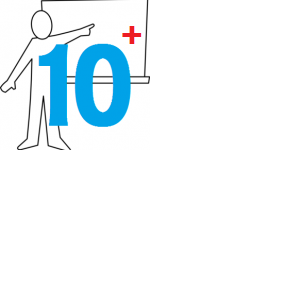 Yesterday I was speaking to my colleague George Machlan about the teachers directory here at learnoutlive. Since he linked back to the directory from his own site, his ranking shot to the top very quickly and he receives regular traffic from our site by students looking for English teachers.
Yesterday I was speaking to my colleague George Machlan about the teachers directory here at learnoutlive. Since he linked back to the directory from his own site, his ranking shot to the top very quickly and he receives regular traffic from our site by students looking for English teachers.
He mentioned that he is thinking about creating a little landing page so that students coming from our site to his will have an easier time of getting in touch with him.
My immediate response was: “Absolutely!“
Every day I notice many students are clicking on the links of teacher’s websites in our directory, but to be honest… if I imagine I’m a student and I arrive at some of these websites it’s often not very clear how to contact/book lessons with the teacher. It’s not that teachers fail to include a contact form and payment buttons, but it’s that many webpages are simply too cluttered.
This is exactly why I’ve started writing this little series about how to create an online teaching website. This is the second part. You can find part one here.
I’m building an example online teaching website while I’m writing this tutorial and you can check out the page here as I’m working on it: http://learngermanviaskype.wordpress.com/
——————————–
We started out last time with a simple WordPress setup on wordpress.com. Today I want to show you how you can include a contact form and payment buttons, the most critical elements for running an online teaching business.
Please note that the following information is specifically focused on wordpress.com. If you already have your own WordPress installation, even better! The principle is the same, although the steps vary a bit (let me know in the comments if you want to know more about self-hosted WordPress systems)
How To Add A Contact Form
The most important aspect of an online teaching website is the contact form. Everything starts from the moment you talk to a potential student. Therefore, we need a way for them to contact you!
1. Creating A New PagePages -> Add New Page
Give the page a title. I chose “contact teacher” but you might even go ahead and call it “Free Trial Lesson” if that’s how you roll (offering free trial lessons is highly recommended and certainly increases the amount of leads)
2. Launching Your Contact Form
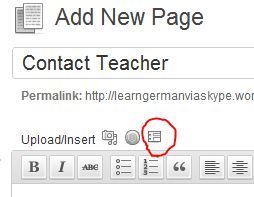
After naming the page click the little icon marked in the screenshot.
You’ll see an overlay with the form options:
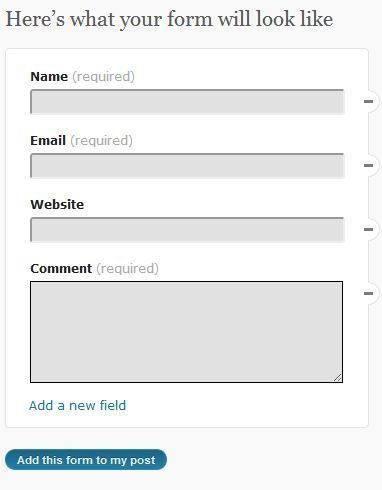
This is the basic setup of the contact form. More or less we can keep it the way it is but since we’re going for an online teaching website, we have to make a few adjustments. First of all, let’s change that text-field where it says “Website” to a field where students can enter their Skype ID so you can easily contact them.
3. How To Edit FieldsTo do this move the mouse over the little (-) symbol next to the Website field and click edit.
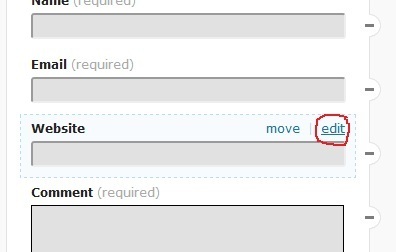
As soon as you do that you’ll get some more options on the right side where you can edit the options of this field.
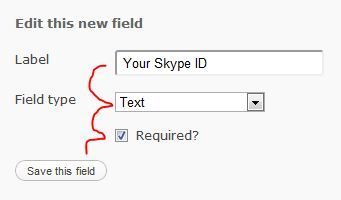
For our online teaching purposes, I just renamed the Label from “Website” to “Your Skype ID”, left the field type as Text and checked the Required field which means that without entering the Skype ID the form will not be sent. It’s good to have the email of a student but it’s even better to have the Skype ID because it allows you to react faster. And in the online teaching world, fast reaction time is an important asset.
When finished, click Save this field.
What else can we do?
Let’s say you’d like to receive some more information about a student’s learning status when they request a lesson. No problem!
4. How To Add More FieldsSimply click on “Add a new field” and you’ll be able to create a field from scratch.

The magic here is all in the Field Type. Depending on what type you choose you get different options. In our case I’ve chosen Drop Down which allows me to add a variety of preselected options users can choose from. This way whenever someone comes to my online teaching page, they can easily include their learning status with a simple click.
When you’re done hit Save.
Then you’ll see a preview of your form. You can easily change the order of the fields by dragging them.
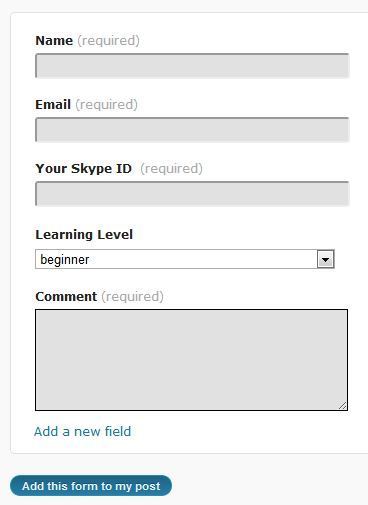
This is a really basic form we got now and I would recommend not to add too many options! The more fields you make people fill out the less likely it becomes that they’ll follow through to the end. You know how annoying it is to fill out these forms yourself. Have a heart!
In the past, I have had great success by even using only 3 fields (name, email, skype ID) and while other teachers always told me I should include more options it generated lesson requests en masse, many of them leading to paying clients down the road.
5. Getting The CodeNo matter how you choose to compose your contact form, when you’re done hit the blue button that says “Add this form to my post”.
You’ll then be teleported back to your page editing screen.

Do you see all of that code? This is your contact form! You can add text before or after the code (example: “Request a lesson with me below”) but make sure not to break the code.
Everything set? Hit Publish. And voilá!

A you can see there’s the Sharing and Liking section again which just distracts people. We don’t want them to get lost on Twitter or Facebook. We want them to do one thing and one thing only: fill out the contact form. Look here (step 9) how to disable these sections. (Also you can disable them permanently by going through Settings -> Sharing

Also, don’t forget to turn off the comments on the Contact Form page. (Remember? Look at step 8 here)
7. Getting A Payment ButtonOkay, now we’ve got the lesson request / contact form. What if students want to purchase lessons? We’re going to need some payment buttons. (Please note that since we’re working with WordPress.com and not the self-hosted WordPress in this tutorial, our options are a bit limited and we have to do some workarounds, but again, I want to show that even without investing a single cent it’s possible to launch an effective online teaching website.)
Go to Paypal’s button generator page (click here)
There you’ll be able to set the button type (select Buy Now), give it a name and price. It’ll also show you a preview.

This is a very basic button and there isn’t much more too it. Simple is the best!
Once you’re done, hit .. Done.
At the bottom, don’t forget to enter your Paypal email address where the monies will be sent to.

When done, hit “Create Button”
8. Save the Image Of The ButtonNow you’ll see the code for your button and a preview. Unfortunately, due to the constraints of WordPress.com (on self-hosted blogs this is no problem) we can’t just copy the code to get the button, but here’s a workaround:
Simply do a right click on the graphic and click “Save image as…” (Chrome) or “Save image as…” (Firefox) etc.
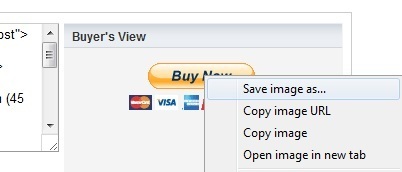

Switch the tabs where it shows the code to “Email”. Select and copy the link.
10. Putting everything together.Back in WordPress, create a new page (Pages -> Add New Page) and give it a title, e.g. “My Rates”, “Bookings”, etc.
Now we’re adding the image of the button and pasting the link into the field where it says: “Link URL”

Once the image and the link are inside, add some descriptions to the button.
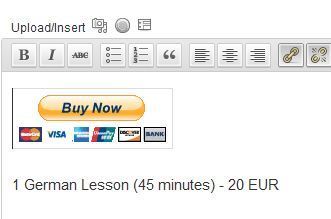
When done, hit publish and … you’re done!
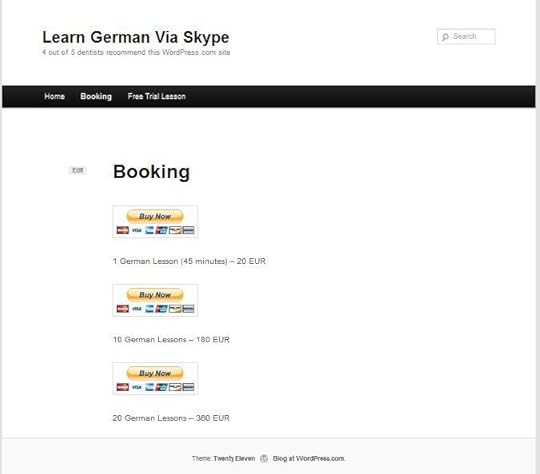
Here’s my example! I repeated the above steps to create three different buttons with different lesson packages. Check out the demo site below:
learngermanviaskype.wordpress.com
How About You?Is your site simple enough that people can easily request trial lessons or contact and pay you? Or are your potential clients drowning in a sea of information which is all very titillating but in the end just interferes with the business side of things…
Now it’s your turn! Time to get busy…
Was this tutorial helpful for you? I certainly enjoyed writing it. But…what else would you like to see? Leave a comment!

 About the author:
André Klein was born in Germany, has grown up and lived in many different places including Thailand, Sweden and Israel. He has produced two music albums, performed and organized literary readings, curated an experimental television program and is the author of various short stories and non-fiction works.
About the author:
André Klein was born in Germany, has grown up and lived in many different places including Thailand, Sweden and Israel. He has produced two music albums, performed and organized literary readings, curated an experimental television program and is the author of various short stories and non-fiction works.
July 4, 2012
10 Steps To Your Online Teaching Website
 We all see dozens of websites every day. There are many great ones and even more not so great ones. Especially when it comes to online teaching websites I found that many online teachers are needlessly complicating and cluttering their websites, whereas a more user-centric approach can do real wonders in increasing student engagement and of course bookings of lessons.
We all see dozens of websites every day. There are many great ones and even more not so great ones. Especially when it comes to online teaching websites I found that many online teachers are needlessly complicating and cluttering their websites, whereas a more user-centric approach can do real wonders in increasing student engagement and of course bookings of lessons.
The Myth Of The Perfect Website
A common misunderstanding is that in order to have a great website you need a) an artistic background, b) otherworldly programming skills and c) a lot of money.
These are at least the excuses that you hear when people speak about their sites: “I’m not a designer.” – “I’m not a programmer.” – “My budget was really low.”
But in the end those are just excuses. You neither need to be a Picasso, Zuckerberg or Rockefeller. All you need is common sense and a willingness to experiment.
(I always recommend to purchase your own domain and webspace, but for the sake of example you can also go the route of free)
1. Register a WordPress Site
Go to http://wordpress.com to register
2. Name Your Website

You can still change this later, but please note that I put in my keywords (learn, german, skype) both in the title and in the address. This can help search engines to find me better than just calling it Lederhosen or whatnot.
3. Choose a Theme
Stick with the default for the beginning. It’ll help you not to get distracted early on by too many visual elements. You can also always change it later.
4. Preview Your Site

5. Change/kill the Header
This theme is great but the header graphic is a bit blockish and takes up too much screen real estate. We don’t want people to have to scroll down all the time.
You can kill/change the header under Appearance->Header->Remove Header image

Now, this is a lot better, since you can get a good overview of the important elements. I’ve colored them for you here:
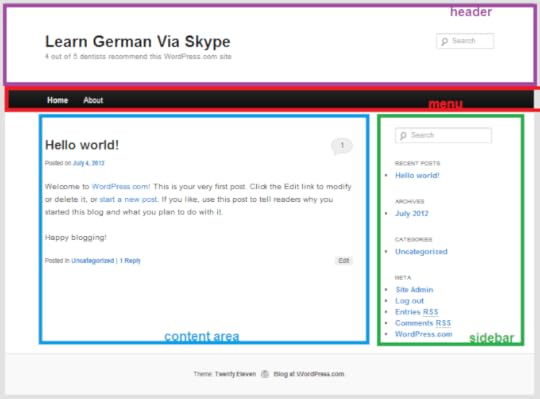
6. Create a Welcome Page
As you can see the content area shows blog posts by default. Since we’re aiming at building an online teaching website, the blog should not be the first thing that people see, we can include it deeper within the page, later.
Go to Pages -> Add New in your WordPress Dashboard and create the face of your website.

(a picture and a bit of text is enough. This is about a first impression of your online teaching approach/personality, not about details)
7. Make Your Welcome Page The First Thing People See
After creating this first page, your site will still show blog posts as default in the content area. In order to change that, go to Settings -> Reading and select the following:

Don’t forget to click “Save Changes”

We’re getting there. One thing that is a problem here, though is the “leave a reply” field below. We don’t want to confuse people and have them think this is a blog post. This welcome page like the entry hall to your online teaching business, not a spot for debates.
8. Disable Comments For Pages
This is a bit tricky for beginners, because it’s hidden, but its’ super simple.
Go to Pages -> All Pages and edit your Welcome Page
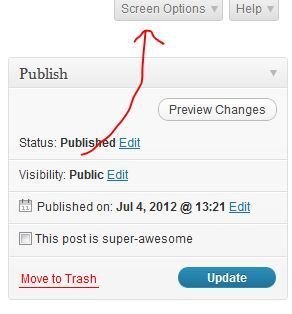
On top of the page you will find this little Screen Options tab. Click it.

This will allow you to show a lot of different options that are usually hidden by default. Tick discussion and close the screen options tab by clicking on it.

Now, under the field where you wrote your page content you will find another box has appeared, titled “Discussion”. Just untick where it says “Allow comments” and you’re good.
Note: You just have to do this once. From now on this Discussion module will always appear when editing posts or pages.
9. Removing More Clutter
Now it should look better…

Aah, that’s better. The Share this/Like this section is still a bit confusing for the eye (we don’t want people to get lost on Facebook/Twitter but be engaged with our site!)
Here’s how to get rid of that, too. Under the module “Discussion” from the last step there’s another module called Likes and Shares.

Just untick both options to get a clean page.
And don’t worry, there’ll still be lots of other ways to put Social Media buttons on other parts of your site. No need to feel guilty for being “unsocial”. What counts for now is distraction free design. Check it out:

10. Bask in the Glory of Your New Site
So far we’ve mostly removed stuff, but we’ve laid the groundwork for a great online teaching website. It’s okay to be proud! 
TO BE CONTINUED…
In the next post I’ll show you how to add a contact form, buttons for lesson payments and more…
…
Was this helpful for you? What else would you like to see? Leave a comment!

 About the author:
André Klein was born in Germany, has grown up and lived in many different places including Thailand, Sweden and Israel. He has produced two music albums, performed and organized literary readings, curated an experimental television program and is the author of various short stories and non-fiction works.
About the author:
André Klein was born in Germany, has grown up and lived in many different places including Thailand, Sweden and Israel. He has produced two music albums, performed and organized literary readings, curated an experimental television program and is the author of various short stories and non-fiction works.
July 1, 2012
The Problem With Ebooks…
If you dig beneath the surface, many people’s problem with ebooks is not that they don’t smell.
Jani Patokallio writes:
Crippled by territorial license restrictions, digital rights management, and single-purpose devices and file formats that are simultaneously immature and already obsolescent, they are at a hopeless competitive disadvantage compared to full-fledged websites and even the humble PDF.
Let’s take it one at a time:
Territorial license restrictions?
True. It leads to very absurd situations, like when I published a story about the Middle East while being in the Middle East and then having Amazon tell me it’s not available in the Middle East. I wish this was just a problem with ebooks… As a non-American I’m blocked from Netflix and Amazon for streaming movies. In Germany everyone could watch the soccer euro-cup as a free livestream, but all I see from here is: “Not available in your country.” Hulu? Pandora? Everything is blocked by the politics of territorial license restrictions.
Digital rights management?
Yes, publishers still do it and think it prevents privacy while it clearly just frustrates those who purchased a book legally and want to convert/transfer it to a different device. If people want to pirate your book, they’ll do it with or without DRM.
Single purpose devices?
My Kindle doesn’t do a lot of things, that’s right. But to be honest, I’d be happier if it did even less! The sole purpose of an ereader should be to facilitate reading. If it does that and does it really well, great! Contrary to the hype of multimedia augmented ebooks the power of a book is very simple: words put together, one after the other, arranged in paragraphs that please the eye. Tablets like the iPad also do ereading but there’s always a danger of slipping away, dipping into Twitter, just skimming or being distracted by incoming email.
Websites and PDF are better than ebooks?
There have been studies (quoted in Netsmart) which show that readers remember significantly more from a text without hyperlinks than from one which sends them out into a spiralling galaxy of cross references. The word is a cliché, but it’s true: hypertext-less text is more immersive. And PDFs? Well, they are beautiful but their fixed layout makes fluid reading on different screen sizes a pure horror.
 To summarize, none of these criticisms is really about the concept of ebooks per se, but “the problem with ebooks” is actually a problem with politics and ecosystems. It’s the publishers and marketplaces (forced by laws and lobbies) that are limiting the way ebooks can be purchased and consumed. On top of that there’s the confusion about the nature of ebooks. Should they have integrated twitter feeds and pop up ads? Or are they still about the text itself?
To summarize, none of these criticisms is really about the concept of ebooks per se, but “the problem with ebooks” is actually a problem with politics and ecosystems. It’s the publishers and marketplaces (forced by laws and lobbies) that are limiting the way ebooks can be purchased and consumed. On top of that there’s the confusion about the nature of ebooks. Should they have integrated twitter feeds and pop up ads? Or are they still about the text itself?
In this complex entangled mess it’s often easier to blame the ebook itself and flee into leather bound romanticisms of ink and dust.
But in the end, books and ebooks have a lot more in common than we tend to admit.
Like my friend Brian The Book said: “[both books and ebooks] are about imagination and ideas” and we should all chill out and eat some ice-cream.
The past is not coming back. And the sooner publishers, law-makers and marketplaces understand this, the better.
-

 About the author:
André Klein was born in Germany, has grown up and lived in many different places including Thailand, Sweden and Israel. He has produced two music albums, performed and organized literary readings, curated an experimental television program and is the author of various short stories and non-fiction works.
About the author:
André Klein was born in Germany, has grown up and lived in many different places including Thailand, Sweden and Israel. He has produced two music albums, performed and organized literary readings, curated an experimental television program and is the author of various short stories and non-fiction works.
June 27, 2012
Piracy is Free Promotion?
I always told myself that if someone stole my stuff and put it online that it would be like free advertising. Only that never anyone seemed to care enough to steal my stuff. Piracy seemed like a gesture reserved for the rich and famous. Free promotion? Maybe, but not for me.
Yesterday, however, I had a chance put my assumptions to the test.
Someone had taken one of my experimental publications for German learners (remember “Peter und das Huhn“?) and uploaded it to a variety of different filesharing sites known for ebook piracy.
“So that’s how it feels!”My first thought was: “So that’s how it feels!” It was a strange sensation, the fact that someone (maybe it was just a faceless content scraping bot) cared enough to duplicate this little book and made it accessible to everyone was weirdly gratifying. Since the book is linked to my blog and other books, it’s a great help promotion wise.
But to be honest, I also wondered what would happen if all my publications received the same attention. Would people still purchase them? Or would I have to join the ranks of starving rock stars and directors slain in the wake of the piracy steam roller?
Having said that, I don’t think that piracy should be either forbidden or encouraged.
It’s just a fact of online existence. Piracy can’t be prevented. The moment we stop trying to apply pre-digital categories like “property theft” to the inevitable flow of sharing information online, the paper tiger of piracy turns into a little kitten.
Answering with lawsuits isn’t just a failure of seeing the promotion potential, it also puts a dent in the image of content creators, however moralistic their arguments.
Instead of fighting the bad, promote the good!Each case of piracy vs promotion has to be scrutinized independently, but as a general advice, the same rule applies here as with online reputation management: You can’t get rid of bad information about you online, but you can do your best to constantly create and share good data that will be found instead.
In other words: don’t wait until the pirates “steal” your stuff. Steal it yourself! Make it free, make it public, in whatever way you can (we all got bills to pay).
To underline this, I have made the above mentioned publication now free for everyone to download from our shop, no strings attached. The download comes with a shiny new PDF version, plus a mobi and epub edition for your Kindles, Nooks, etc. But wait, it gets even better…
There’s also a brand new picture book for German learners that I finished last week and which is also – guess what – free, at least for the next 48 hours. Click here, or on one of the links below.
Amazon UK – Amazon US – Amazon DE – Amazon IT – Amazon FR – Amazon ES
And remember: If it cheers you, leave a review!
-
img: CC by Yodel Anecdotal

 About the author:
André Klein was born in Germany, has grown up and lived in many different places including Thailand, Sweden and Israel. He has produced two music albums, performed and organized literary readings, curated an experimental television program and is the author of various short stories and non-fiction works.
About the author:
André Klein was born in Germany, has grown up and lived in many different places including Thailand, Sweden and Israel. He has produced two music albums, performed and organized literary readings, curated an experimental television program and is the author of various short stories and non-fiction works.
June 24, 2012
Not a Game: Being Indie (a movie)
 Free to do whatever and whenever you like: it’s everyone’s dream, isn’t it?
Free to do whatever and whenever you like: it’s everyone’s dream, isn’t it?
Whether you’re in publishing, teaching or web design, once you kiss your job goodbye and decide to brave it out alone you will need a different toolkit.
In the employment world it’s all about permission and expectation, and more often than not, it’s the employer calling the shots, not the employee. The frame is already there, the employee has to fit in, even if she has to squeeze and violently tuck in her edges.
In the freelance world (the term literally means “medieval mercenary warrior”: not a gun, but a lance for hire) it’s all about drive and dedication. Of course it also helps to be incredibly skillful and have a huge clout, but first and foremost comes the drive to get started and the dedication to get things done.
In other words: it’s not about who you are but what you do.
As someone who is both an independent publisher and educator, I’m always keen to hear from other independent people in different fields such as music production and distribution.
What I found so far is that the similarities almost always outweigh the differences.
Take indie game development for example. In the highly recommended documentary Indie Game: The Movie we see a handful of game developers struggling for fame (and sanity) on the everyday roller coaster of doing stuff outside of the box.
While the pressure can be intense sometimes (no leagues of co-workers to push it onto) the reward of doing stuff you love and seeing it succeed is worth it.
Here’s the trailer of the film, which won the Sundance Award for Best Editing and (of course) was independently produced, too. Show this to everyone who says video games are a waste of time:

 About the author:
André Klein was born in Germany, has grown up and lived in many different places including Thailand, Sweden and Israel. He has produced two music albums, performed and organized literary readings, curated an experimental television program and is the author of various short stories and non-fiction works.
About the author:
André Klein was born in Germany, has grown up and lived in many different places including Thailand, Sweden and Israel. He has produced two music albums, performed and organized literary readings, curated an experimental television program and is the author of various short stories and non-fiction works.
June 20, 2012
The Key To Online Teaching Business: Paying It Forward

Recently, I’ve been reading Howard Rheingold’s Net Smart, a brilliant book about 21st century online learning, networking and “crap detection”, in short: essential skills for our daily online life and business.
And there was one sentence that kept appearing and reappearing in my mind’s eye long after I put the book down.
the strongest predictor of whether someone will assist you online is whether you’ve aided others.
If there was a golden rule of doing business online, this would be it. I’ve written about it many times myself, but I’m still surprised every time I experience it.
It’s not just a catchy statement, it’s actually true!
Indirect Compensation
People immediate think: “Yeah, right. But altruism doesn’t pay my rent.” And it’s true, we all have self-interest, we all need to make ends meet.
But “aiding others” online doesn’t mean that you don’t get compensated, you just don’t get compensated directly.
I wouldn’t be writing this post right now if it weren’t for the help of all the people who’ve supported me in my online teaching business and publishing journey.
Why did people help me? It’s funny, because many times I’ve been helping someone online without expecting any direct gains, and then suddenly from a completely different direction someone else helped me.
Is there a law to it? Howard Rheingold has some ideas and data about it. To me, the main point is that it works.
Be generous, give of yourself without expecting anything. You’ll be surprised!
Online Teaching: The 21st Century Way Of Education
Two of the people who helped me* very recently with the 4th edition of my book “How To Teach Online Without Selling Your Soul” are Michael Gyori, who assisted with grammar, style and content, and Kirsten Winkler, who contributed a brilliant foreword.
Although I’ve never met either of them in person (he’s based in Hawaii, she in France and I’m in the Middle East) we collaborate frequently, because we share the same fascination with the online teaching business and education in general.
For those who are at the beginning (or middle) of building their online teaching business and feel the need for a gentle push or pointer into the right direction, I’m glad to tell you that the 4th edition of “How To Teach Online Without Selling Your Soul” is now up and running.
To kick things off, it’ll be available for the next 24 hours on Amazon for a special price of $2.99 instead of the usual $7.99, just follow the link to the Kindle store of your choice:
Amazon (US) | Amazon (UK) | (DE) | (ES) | (FR) | (IT)
Grab your copy now, and if you like it, tell your friends or leave a review. It means a lot to me.
Thanks!
P.S.: If you’d rather just have some more traffic to your online teaching business website and skip the extra advice, you can get listed here for free.
P.P.S.: Big thanks also to Sylvia Guinan, Glenn Weidner, Mo Riddiford, María Inés Brumana Metodología and many more, who contributed their comments, suggestions and encouragement along the way of this publication process.
-
img: CreativeCommons, hikingartist.com

 About the author:
André Klein was born in Germany, has grown up and lived in many different places including Thailand, Sweden and Israel. He has produced two music albums, performed and organized literary readings, curated an experimental television program and is the author of various short stories and non-fiction works.
About the author:
André Klein was born in Germany, has grown up and lived in many different places including Thailand, Sweden and Israel. He has produced two music albums, performed and organized literary readings, curated an experimental television program and is the author of various short stories and non-fiction works.
June 14, 2012
A Call To All Independent Teachers

When we started building this site two years ago we didn’t want just another ‘platform’ containing thousands of teacher and student profiles. The Internet already feels impersonal enough sometimes, doesn’t it? So we limited the number of teachers on our site to only one per subject, i.e. language.
This allowed us to keep in touch with each other, exchange information and support one another throughout the online teaching process without drowning in a sea of contacts and mailing lists.
But it was only the first step, because as teaching slowly morphed into publishing, we continued to make friends and connections in the online education space and learned a lot more about the challenges and daily struggles of online teachers today.
The Way Of The Independent TeacherSome call themselves freelancers, but I think speaking of independent teachers is even more apt. What defines the independent teacher?
He/she doesn’t work for one school or institution (exclusively), instead he only answers to his student’s needs and her own passion for teaching.
Being an independent teacher is challenging (and rewarding) in many ways, because you don’t just do the teaching and the odd teacher’s meeting once in a while, but you do everything from marketing your service to customer support. In other words, you get to do things your way, but you also have to buckle down and make sure enough students find their way into your classes or sessions so you can pay the rent.
A Free Directory For Free SpiritsThis is why I’m very happy to report that we’ve opened learnoutlive to teachers all over the planet. Yes, we’ve created an open directory where teachers can submit their websites.
“Okay, but what do I get for submitting my site?”
You get listed with your name, the subject you teach, a short description and a link to your site of course. By browsing our directory students can find your site and get in touch with you directly. But not just that, these links are valuable “dofollow” links which means that they raise the importance of your own site in the eyes of search engines and help to increase your search ranking.
“I don’t have a website, can I still participate?”
Nope, sorry. You’ll need your own site. Please note that we don’t accept links to profiles on corporate teaching platforms. You’ll have to sign up with your own site, preferably on your own domain. Why this restriction? When a student googles “learn English online” for example, the top search results are occupied by companies that spend thousands of dollars on advertising and search engine optimization. In other words, we don’t want them to get even more popular, they already get enough attention. Instead, we want to help independent teachers with limited resources to get their sites noticed!
And who knows, maybe it will inspire teachers who don’t yet have their own site to create one. Facebook and tumblr are all great but they don’t replace owning and building on your own turf online.
“What Does It Cost?”
Nothing. Nada. This project is both free as in “freedom” and free as in “free beer”. Anyone can sign up, just like that.
How? Click here! (or check out the directory first)
Once you’re done submitting you’re site, you’ll be asked to tell your friends or link back to our site. While we of course get super excited if you share the love, it’s not obligatory.
If you have any questions, please use the comment form below.
-
img: Some rights reserved by HikingArtist.com

 About the author:
André Klein was born in Germany, has grown up and lived in many different places including Thailand, Sweden and Israel. He has produced two music albums, performed and organized literary readings, curated an experimental television program and is the author of various short stories and non-fiction works.
About the author:
André Klein was born in Germany, has grown up and lived in many different places including Thailand, Sweden and Israel. He has produced two music albums, performed and organized literary readings, curated an experimental television program and is the author of various short stories and non-fiction works.
June 10, 2012
When Stuff Gets Stolen And Value Skyrockets
In a world where heavy (regional) restrictions apply to downloading movies and music in a legal way, it’s no surprise that many people choose to take the route of free.
Anti-piracy zealots claim that downloaders are curmudgeoning pinchfists. That’s open to debate. But complicated (and proprietary) purchasing procedures of online media certainly don’t make paying any more compelling.
This is why I find the response of filmmaker Tom Lowe who discovered that his film got stolen and put on the Pirate Bay so interesting. Instead of lawsuits he just left a friendly comment, asking people to buy the film if they like it.
His upfront response has earned him the respect of the Internet, and it’s a good example to follow (remember what happened when Metallica started whining about downloads?).
In an interview with techcrunch Tom Lowe said:
I wasn’t upset about the torrents. I knew it was going to happen [...]
When I saw the torrent, I felt like letting downloaders know that this was a small, self-financed film, and there are not any Hollywood fatcats in the revenue stream. [...] If you want reduce file sharing, I think you should offer fast, secure, relatively inexpensive, DRM-free downloads in as many flavors as possible. [...] I just see piracy as a reality. I don’t really see it as good or bad. Artists need to accept that this is reality now, and adapt their business models around reality.
Talking about making movies and offering them in as many formats with as little hassle as possible, have you heard about Indie Game: the movie? Their film is coming out in a few days and I can’t wait to see it. To me, paying for products like this is not just the result of a cold cost-benefit analysis, it’s a political action.
By supporting independent works of art and their independent networks of distribution we are showing that there is an alternative to the ‘entertainment industry’ and its draconian measures.
It’s not enough to just say “no”, we need to prove that another world is possible, whether we are content creators or consumers.
-
img: morguefile license, snowbear

 About the author:
André Klein was born in Germany, has grown up and lived in many different places including Thailand, Sweden and Israel. He has produced two music albums, performed and organized literary readings, curated an experimental television program and is the author of various short stories and non-fiction works.
About the author:
André Klein was born in Germany, has grown up and lived in many different places including Thailand, Sweden and Israel. He has produced two music albums, performed and organized literary readings, curated an experimental television program and is the author of various short stories and non-fiction works.
June 4, 2012
Why German Grammar Is Dead Simple (free download inside)
A while ago these images were making the rounds about how German sounds cruel and gritty compared to other languages.
And while the prejudice of Teutonic doom and gloom will probably not come off any time soon (thanks Wagner) there is another prejudice which is just as widespread, namely that German grammar is impossibly difficult.
Grammar My Problem Child
Teaching languages for more than ten years I always had a peculiar relationship to grammar. I still remember when my Latin teacher showed us a double page of declensions and told us: “Memorize until tomorrow!” As if…
In other words, I slogged through my own schooling with the minimum of grammar. Until the end of high school I couldn’t tell apart an accusative and a dative if it stared me straight into the face.
All this was to change dramatically when I began working part time as a language teacher (yes, regardless of being completely oblivious when it came to grammar my grades in German, English, French and Spanish had always been above average).
As part time slowly became full time I noticed that without grammar, certain things were impossible to explain to my students.
Thus I started studying grammar in an unconventional way: by teaching it. I started building up a whole complex of grammar based on questions and misunderstandings of the students. Instead of starting from a textbook, I started from what students actually needed. Through the years (by listening to linguistic lectures and going through the obligatory grammar training as a teacher student in univsity) I refined this approach, but it always remained grounded in the simplicity of necessity.
After intensively teaching German as a foreign language to adults in the last two years I kept developing and refining this approach. And now I finally started to write it all down, so that people outside of the classroom can benefit, too.
The format of the publication is just as unconventional as the approach it contains. It’s short, painless (for a small price) and you can get it for free for the next 48 hours.
This first installment deals with something very fundamental: basic verb conjugation.
Here’s an excerpt from the introduction:
Instead of overwhelming you with hundreds of pages crammed with theories, rules and regulations, this guide leads you through the world of German grammar in small measured steps while throwing in some fun along the way.
Each guide is very short and focuses only one topic. The explanations are simplified so that even learners without previous grammar studies can effortlessly grasp core concepts. Navigation is enhanced through a clear structure, icons and illustrations to make reviewing and memorizing even easier.
Last but not least, at the end of each guide you’ll find a wide range of exercises in which you can test your knowledge, learn new words and experience the theory in action.
Before I forget, here’s the link.

 About the author:
André Klein was born in Germany, has grown up and lived in many different places including Thailand, Sweden and Israel. He has produced two music albums, performed and organized literary readings, curated an experimental television program and is the author of various short stories and non-fiction works.
About the author:
André Klein was born in Germany, has grown up and lived in many different places including Thailand, Sweden and Israel. He has produced two music albums, performed and organized literary readings, curated an experimental television program and is the author of various short stories and non-fiction works.
May 30, 2012
Biblical Hebrew For Beginners (a free download)

If the Internet had a religion, would it be monotheistic, paganistic or atheistic?
Honestly, I don’t have a clue, but I do know that beyond popular debates about which religion is more superior for whatever reasons, or whether science and religion can coexist at all, etc. there is another aspect of religion which is often overlooked.
I always say that if you want to understand a culture you have to look at its religion (or the remains thereof). In many ways culture and religion are inseparable. Also, cultures produce and are defined by artifacts, or works of art.
One of these artworks, often misunderstood or abused as a base for pamphlets and crusades big and small is the Bible, that ancient book without which Christianity, Islam and Judaism are impossible to imagine. This is not the place to go into a deep analysis of how these religions and their beliefs, myths and legends are related or overlapping, but it’s a fact that the Hebrew Bible (also know as Tanakh) and the stories it tells (from Adam & Eve to Cain & Able, Noah & the flood, Joseph & his brothers, Moses & the exodus, etc.) is very much alive and still captures the imagination (or criticism) of humanity up to this day.
One of the reasons why religions are getting more and more unpopular (at least in the Western World) is the fact that people have been taking these stories (and the laws and commandments derived from them) too literally and caused havoc both locally and globally.
Personally, I think the Bible is simply one of the greatest works of literature ever produced, and I don’t consider myself religious, at all. To me, it is a great compilation of myths, inspirations, lamentations, dreams and fears which can be a gateway into human psychology, history, archaeology and many other disciplines.
Troubleshooting Ludicrous Interpretations By Following The RootsAs a literary work of art, the Bible is fundamentally open to interpretation. Historically, there are some interesting misinterpretations that reveal themselves only when looking at the Hebrew root text.
To give you an example, there’s that famous prejudice that “Jews have horns”. Michelangelo, when sculpting his Moses, even added two little stubs to his forehead. But why? It turns out that this is based on a grave misunderstanding of the Hebrew word קֶרֶן which the Latins translated as “corns” but also is “a term equivalent to “radiant”‘ (source)
This is just one example of many thousands. And one doesn’t need to be a professor to see these things. Often just a few words read in the original give a completely different picture than the translation. (Hebrew in itself is a very ambiguous language which lends itself to poetry, but in less ambiguous languages like English many facets get lost in translation)
Learning Basic Biblical Hebrew With 10 Popular Phrases From ExodusWe’ve already released various publications for Hebrew learners here at Learn Out Live! Our latest one takes 10 phrases from the Bible (chapter Exodus) and encourages beginners to make their first steps in unlocking this ancient text, word by word. Here’s the blurb:
Reading the Bible in Hebrew can be a daunting prospect for beginners. But if we take it step by step, it’s easier than most people think. The first step is to learn the Hebrew letters, the second to learn single words and then short phrases. This publication is a compilation of ten popular Hebrew phrases from the Book of Exodus.
Each phrase is presented in bold, easily readable letters within an aesthetically pleasing layout, complete with meta-information regarding the location of the phrase in both the Hebrew and English Bible.
By flipping the pages readers can delve deeper into each phrase, learning the correct pronunciation, translation and context of each phrase. In addition to that, there are notes about various Hebrew peculiarities and links to (free) websites containing audio, vocabulary and further information.
In keeping this volume as digestible and open as possible, we hope that it will act as a springboard into the rich and endless world of Biblical Hebrew.
And here’s the download link (free for the next 48 hours)
P.S.: the book cover in itself has an interesting story which I documented on my personal blog.
-
img: Some rights reserved by Lawrie Cate

 About the author:
André Klein was born in Germany, has grown up and lived in many different places including Thailand, Sweden and Israel. He has produced two music albums, performed and organized literary readings, curated an experimental television program and is the author of various short stories and non-fiction works.
About the author:
André Klein was born in Germany, has grown up and lived in many different places including Thailand, Sweden and Israel. He has produced two music albums, performed and organized literary readings, curated an experimental television program and is the author of various short stories and non-fiction works.









